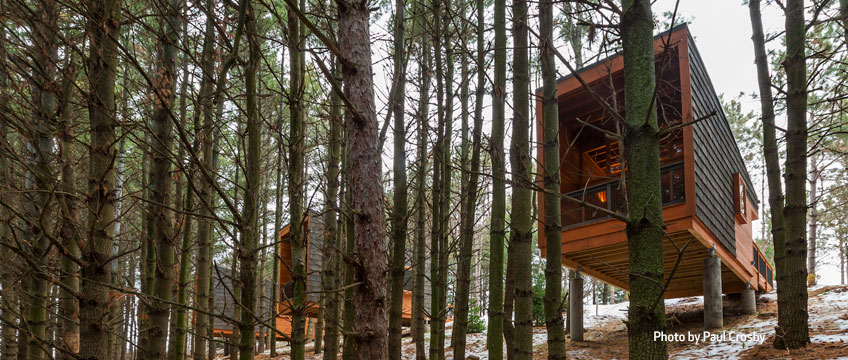A new Dakota County park offers visitors a variety of landscape settings and activities—and three memorable camping cabins in the pines
By Amy Goetzman
When you conjure a park in your mind’s eye, you probably zoom in on distinctive natural features and attractions—a stand of shade-giving trees, for example, or a tranquil pond. But the first experience you have at most parks is of the road that takes you to those things. A way in, a way out. The road into Whitetail Woods Regional Park near Farmington, Minnesota, is something more. Drivers slow down to enjoy it.
“I was taken by the idea of designing a special road that would amplify and reinforce the already amazing places this park had to offer,” says former HGA Architects and Engineers landscape architect Ross Altheimer, who earned his graduate degrees at the University of Virginia, where the iconic Blue Ridge Parkway made an indelible impression on him. “I wanted to create a sequenced, orchestrated series of views that unfolds as you enter the landscape.”
The landscape at Whitetail Woods, Dakota County’s newest park in 25 years, has a wild, wide-open feel. As you drive into the 456-acre preserve, the road curves dramatically away from neighboring farmland into a great swath of rolling prairie. Wetlands follow, then a ridge topped with pines and three remarkable little cabins looking into the woods. Around the next bend, the land swells, and the road loops around to end just below a main shelter building, which looks poised to take flight. Just behind it is an open space designated for flying kites when the wind picks up.
“Working on a landscape of this scale requires a different way of thinking,” says Altheimer. “You aren’t bringing a big object to a small space, as you are in most projects. Instead, you have to think of it as a circulation network, with roads and paths leading out to activities and things to be discovered.”
The parkland, which includes a picturesque little lake, was contoured by glacial retreat—and then shaped some more by agricultural uses. “It was an already-constructed landscape. But a constructed landscape is cultural too and worth considering,” Altheimer continues. “So we spent a lot of time hiking the site and noting the elevation, trees, all the interesting features, and thinking about how to position the architecture.”
HOUSES IN THE TREES
Meanwhile, the architects were doing the same thing. “The charge for us was to establish a palette and a vocabulary for the buildings,” says HGA’s Steven Dwyer, AIA, who designed the camping cabins and main shelter building. “We wanted to do something that would complement the existing environment and the program Ross was working on.” The cabins are purely modern, while the shelter draws on Prairie School influences, per the request of the county. Materials, colors, and rooflines draw the two buildings together while leaving the architects of any future buildings room for interpretation.
“We came up with the idea of single-sloped roofs, and dark cedar shingles offset by natural cedar stain,” Dwyer explains. “We wanted to create something simple enough that future buildings could follow it. We also wanted to create something that would be respectful to the landscape. That meant staying low, choosing natural colors, and not competing.”
The cabins are like no others you’ll find in Minnesota. HGA scrapped the traditional log cabin aesthetic in favor of a crisply designed shelter that provides both privacy and big views. Each cabin is positioned on the ridge to give occupants an elevated view through the trees.
“We talked about tree houses and actually explored that idea quite seriously,” says Dwyer. “But the trees wouldn’t have been strong enough, and accessibility was an issue. So instead we focused on the experience. If we couldn’t do a tree house then we would do a house in the trees.”
Early in his career, Dwyer worked for noted architect James Stageberg, and he spent some time at Wind Whistle, Stageberg’s Wisconsin cabin retreat. “I wasn’t conscious of it when I was designing these cabins, but I know how impressionable I was at that time in my life, and Stageberg’s design for a house hugging a cliff must have been at the back of my mind. In a way, these cabins are an homage to him.”
“We felt that now, as we were designing a new park, was the right time to experiment with architecture,” says Bruce Blair, former manager of park facility development for Dakota County Parks. “The board wanted something distinctive, something different than the traditional log cabin. It offers a unique experience, yet it’s affordable and close to home.”
Were Minnesotans ready for something unique? The answer was swift: Within five minutes of registration opening up, the cabins were booked solid from December to April.
“We realized this was a rare chance to design a park for the 21st century,” says Altheimer. “This is just the first stage [of the project]; in the future there will be more cabins, food gardens, more play spaces.
“The last time I visited, I couldn’t believe how many people were doing different things there,” he adds. “I love to design for the public realm. That’s part of the reason I became a landscape architect. How do you orchestrate human experience?”
At this popular new regional park, it’s accomplished with woods and water, trails and room to run, shelter from the wind, and a road to take you there.
WHITETAIL WOODS REGIONAL PARK
Location: Empire Township, Minnesota
Client: Dakota County
Architect: HGA Architects and Engineers
hga.com
Principal-in-charge: Jim Goblirsch, AIA
Project lead designer: Steven Dwyer, AIA
Landscape architects: HGA Architects and Engineers; Travis Van Liere Studio
General contractors: Dakota County; George Siegfried Construction
Size: 456 acres with picnic shelter, trailhead shelter, bathhouse, and three cabins
Cost: $4.7 million
Completion: September 2014
Photographer: Paul Crosby



